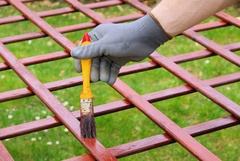Renovation Costs Have Soared
Renovation costs have soared out of control – even during the current recession.
You’d think that renovation costs would be less because home improvement contractors aren’t that busy working on other home improvement projects, and there are plenty of raw materials like drywall, lumber, and concrete.
But there are several reasons renovation costs have stayed relatively high:
- Many home improvement contractors have gone out of business. While quality contractors have stayed busy, many of contractors and sub-contractors have had to leave the business to find other work. That means less competition, which is why prices for home improvement jobs haven’t come down as much.
- Homeowners’ incomes have fallen.Millions of jobs have been lost since 2007 and many of those who have jobs have been asked to take significant paycuts.
- Access to credit is far more limited. Banks have taken a bath on home equity lines of credit (HELOCs) and home equity loans. According to report from Deutsche Bank, homeowners tapped 25 to 30 percent of every dollar of equity they gained during the boom years. With property prices falling, banks have capped or closed millions of home equity lines of credit, as well as lowering credit card lines of credit. That has limited homeowners’ ability to borrow cash to pay for renovation costs.
With limited income and limited access to credit, homeowners have had to either cancel home improvement projects, or manage their renovation costs by doing their project in phases. According to a recent Consumer Reports poll, 36 percent of homeowners plan to do a remodel in several phases to hold down renovation costs.
Manage Renovation Costs with Serial Remodeling
According to the National Association of the Remodeling Industry (NARI), serial remodels, or phased remodeling projects, can go over several months and even years. Homeowners might bite off a piece of a major remodeling project, like fixing up a powder room or closet, and then tackle larger home improvement projects, such as the kitchen, master bath or home addition.
Most people don’t think of their house as consisting of ten separate home improvement projects they want to do and then prioritize them, says Matt Lederer, president of Mahogany Builders in Chicago. “It’s not a one-time shot: People choose projects they can afford and will influence resale,” he adds
Phasing a remodeling project has a number of benefits, Lederer says. For homeowners who can’t fund the entire project upfront, breaking elements of a major home remodel into stages can help extend renovation costs over time and buy homeowners more time to save or find funding. Embarking on a series of smaller projects also keeps homeowners less stressed.
“Everyone has what I call a ‘construction tolerance,'” Lederer says. “Some people get excited about the remodel but a few weeks into it they get tired of people showing up at their house at 7 a.m.”
Lederer recently completed a phased remodel for Jane Tiffen, a Chicago-based condominium owner. In the first phase, which began in 2007, Lederer gutted and remodeled the home’s guest bathroom. He then came back to complete a master suite remodel this spring.
“We had moved into this apartment and knew we wanted to change things,” Tiffen explains. “The bathrooms had the standard run-of-the-mill stuff you find in new apartment buildings, and we wanted to upgrade it. We phased the projects because we wanted to think about how we were going to do it and live in the place for a while.”
Manage Your Landscape Renovation Costs by Phasing In Outdoors Projects
Homeowners looking to renovate their landscape can manage costs by phasing in a landscape redo, experts say. You might first create the land plan and add in the hardscape elements, such as a patio, underground sprinklers, and plant grass. In the second phase, you might add some of the larger elements, such as trees and bushes, and grass. In the final phase, you can add perennials and other plantings.
By spreading out the landscape renovation costs over a two- or three-year period, you can get the look you want on an affordable budget.
Read More: Ebooks from the ThinkGlink.com Store
Last Ditch Efforts: What to do if Your House Still Hasn’t Sold
Join us for Ilyce Glink’s How to Profit From Foreclosures on October 24, 2009
Are you interested in foreclosures? Do you want to buy one to live in or to rent out to help subsidize your retirement?
If you’re interested in foreclosures, you may want to join me for my latest event, HOW TO PROFIT FROM FORECLOSURES. It’s going to be an amazing event, filled with experts you can trust! (Why? Because my team and I will vet everyone who is going to be there. You won’t be hit up for a pitch to spend $3,500 for someone’s DVD program on how to make millions with foreclosures. It’s just excellent and honest information.)
At our event, you’ll pick up tips from top bankers, agents, lenders and REO specialists on how to find foreclosures and negotiate for them; tips from top tax experts and attorneys who know how to negotiate a foreclosure deal and keep you on the right side of the IRS when it comes to investing in foreclosures; and you’ll hear real life stories of successful investors who have made a great living and built up a fantastic amount of equity investing in foreclosures – without gimmicks and expensive DVD tutorials to sell. You’ll hear them tell you what has made them rich and successful.
Sign up now for Ilyce Glink’s How to Profit from Foreclosures and get YOUR foreclosure questions answered.
There are ony a LIMITED NUMBER of early-bird tickets that will be sold. Make sure you get one!







Leave A Comment